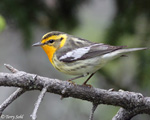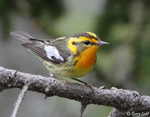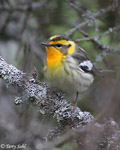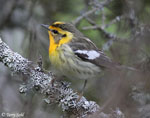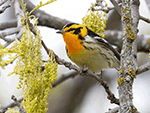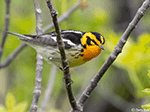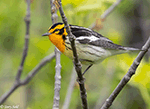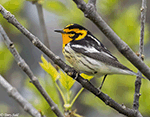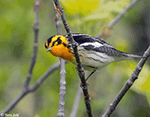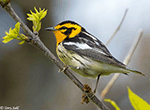Blackburnian Warbler
Setophaga fusca
| Length: 5 inches | Wingspan: 8 inches | Seasonality: Migrant |
| ID Keys: Bright orange on face and throat (yellowish on female), strong dark facial markings, white underparts with streaks on sides. | ||
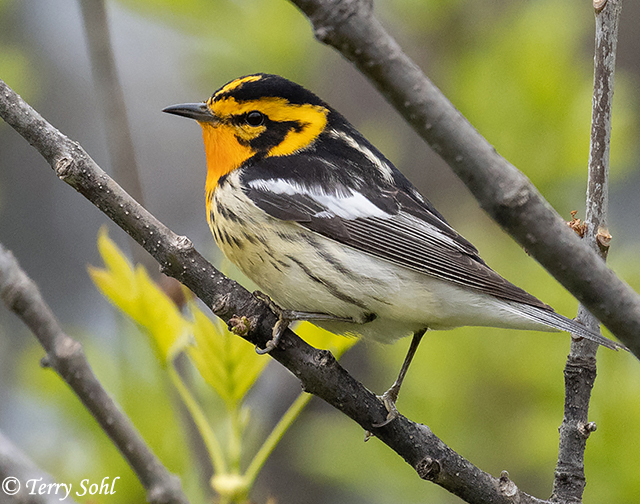 Blackburnian
Warblers are a long-distance migrant, summering around the U.S./Canada border,
and wintering near the forests of the Andes in South America. The
brilliantly colored males often spend much of their time high in the treetops,
especially during breeding season when singing their song. While the plumage
pattern may somewhat resemble other warbler species, the fiery orange color
distinguishes it from most other warblers. They are the only North American
warbler species with an orange throat. The females are more plainly marked, but
still may have hints of the orangish tones of the male. In South Dakota,
Blackburnian Warblers are relatively uncommon migrants, with decreasing
frequency as you move from east to west in the state.
Blackburnian
Warblers are a long-distance migrant, summering around the U.S./Canada border,
and wintering near the forests of the Andes in South America. The
brilliantly colored males often spend much of their time high in the treetops,
especially during breeding season when singing their song. While the plumage
pattern may somewhat resemble other warbler species, the fiery orange color
distinguishes it from most other warblers. They are the only North American
warbler species with an orange throat. The females are more plainly marked, but
still may have hints of the orangish tones of the male. In South Dakota,
Blackburnian Warblers are relatively uncommon migrants, with decreasing
frequency as you move from east to west in the state.
Habitat:
Prefers spruce and hemlock forests on its summer breeding grounds. Can be found in nearly any kind of forest, woodland, or shrubland during migration through the state.
Diet:
Primarily insects, with a strong preference for caterpillars. Will occasionally eat berries, especially during the winter.
Behavior:
Feeding is typically done by climbing on the tips of branches and foliage, usually quite high in the forest canopy. They will also hover and glean insects from the canopy, or occasionally fly out from a perch to catch passing insects in mid-air.
Nesting:
Non-breeder in South Dakota. The nest of a Blackburnian Warbler is a cup built of twigs, lined with mosses, lichens, and hair. It is typically placed in a evergreen, usually quite a bit higher from than ground than other warbler species. The female lays 3 to 5 eggs, and she alone incubates them. The young hatch after about 12 days, and fledge from the nest about 10 days after hatching.
Interactive eBird Map:
Click to access an interactive eBird map of Blackburnian Wabler sightings
Song:
The song of a Blackburnian Warbler is a series of tzeep notes, followed by 2 or 3 higher-pitched whistles. The call is a primarily a short, crisp tsip.
1Click here to hear the song of a Blackburnian Warbler
2Click here to hear the call of a Blackburnian Warbler
Migration:
Summers in southern Canada, the Great Lakes region, and the Appalachians. Winters in Central and South America.
Similar Species:
Male Blackburnian Warblers, with that brilliant orange color and strong plumage pattern, are unlikely to be confused with other species if seen well. Female and immature Blackburnian Warblers have a more subtle plumage and might possibly be confused with several species. Here are the species most likely to be confused with Blackburnian Warbler.
- Townsend's Warbler - Townsend's Warblers are rare migrants in the far western part of the state, while Blackburnian Warblers are primarily found in the eastern part of the state while in migration. However, in the thin sliver of geography where they may possibly overlap in migration, the two species do share similar plumage patterns, but with different colors. Townsend's Warbler males have a strong facial pattern with black around the eye, a black cap, and a black throat, on a background of yellow. Blackburnian Warbler males have a similar strong facial pattern with black around the eye and a black cap, but they lack a black throat (it's orange) and the background color is the brilliant fiery orange typical of the species.
- Bay-breasted Warbler - Female Bay-breasted Warblers may be confused with female Blackburnian Warblers. However, Bay-breasted Warblers have a weaker facial pattern than a female Blackburnian Warbler, with more consistent coloring and a lack of a paler "eyebrow" found on the Blackburnian. Female Bay-breasted Warblers also have unmarked flanks, while immature or female Blackburnian Warblers have faint streaking on the flanks.
- Cape May Warbler - Female Cape May Warblers are similar to female Blackburnian Warblers. However, they lack the darker shaded "triangle" behind the eye of a Blackburnian Warbler. They also have streaks on the flanks that are less extensive than those of a Blackburnian Warbler, which has streaks on the flanks, and the throat.
Conservation Status:
Blackburnian Warblers are considered vulnerable to habitat loss on wintering grounds in the tropical Americas, and there were declines in populations in the 20th century. However, they are some indications of increasing populations in the last 20 years, they are found across a broad geographic area, and they are relatively common in parts of their range. The IUCN considers the Blackburnian Warbler to be a species of "Least Concern".
Further Information:
1) BirdWeb - Blackburnian Warbler
2) WhatBird - Blackburnian Warbler
3) Audubon Guide - Blackburnian Warbler
Image Information:
May 16th, 2020 - Beaver Creek Nature Area, South Dakota - Terry Sohl
Audio File Credits:
1Paul Marvin. Recorded in Nicolet National Forest of Wisconsin on May 24th, 2011. Original recording and information from xeno-canto.
2Andrew Spencer. Recorded in Napo, Ecuador on January 12th, 2008. Original recording and information from xeno-canto.
| Click on the map below for a higher-resolution view |
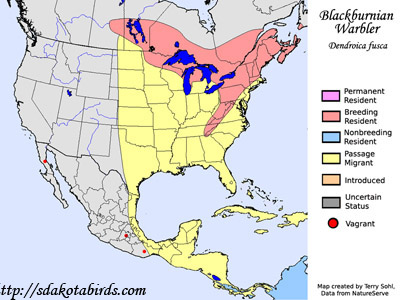 |
| South Dakota Status: Uncommon migrant in the eastern part of the state. |
Additional Blackburnian Warbler Images
Click for a higher-resolution version of these images
